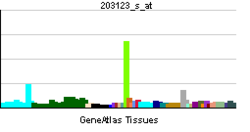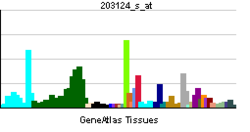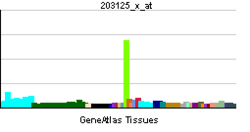- DMT1
-
DMT1 has two forms in the brain + ire and -ire. There is differential expression after injury or aging. Appears to be important in the accumulation of iron in the brain in Parkinson's Disease DMT1 ("divalent metal transporter 1") is a transporter involved in human iron metabolism. It is located on the apical membrane of duodenal enterocytes and transports Fe2+ from the intestinal lumen to the cytosol.
Dietary iron must be reduced from Fe3+ to Fe2+ before being transported by DMT1. This is accomplished by Duodenal cytochrome B.
Further reading
- Vidal S, Belouchi AM, Cellier M (1995). "Cloning and characterization of a second human NRAMP gene on chromosome 12q13.". Mamm. Genome 6 (4): 224–30. doi:10.1007/BF00352405. PMID 7613023.
- Fleming MD, Trenor CC, Su MA (1997). "Microcytic anaemia mice have a mutation in Nramp2, a candidate iron transporter gene.". Nat. Genet. 16 (4): 383–6. doi:10.1038/ng0897-383. PMID 9241278.
- Kishi F, Tabuchi M (1998). "Complete nucleotide sequence of human NRAMP2 cDNA.". Mol. Immunol. 34 (12–13): 839–42. doi:10.1016/S0161-5890(97)00110-7. PMID 9464519.
- Lee PL, Gelbart T, West C (1998). "The human Nramp2 gene: characterization of the gene structure, alternative splicing, promoter region and polymorphisms". Blood Cells Mol. Dis. 24 (2): 199–215. doi:10.1006/bcmd.1998.0186. PMID 9642100.
- Kishi F, Tabuchi M (1998). "Human natural resistance-associated macrophage protein 2: gene cloning and protein identification". Biochem. Biophys. Res. Commun. 251 (3): 775–83. doi:10.1006/bbrc.1998.9415. PMID 9790986.
- Tabuchi M, Yoshimori T, Yamaguchi K (2000). "Human NRAMP2/DMT1, which mediates iron transport across endosomal membranes, is localized to late endosomes and lysosomes in HEp-2 cells". J. Biol. Chem. 275 (29): 22220–8. doi:10.1074/jbc.M001478200. PMID 10751401.
- Griffiths WJ, Kelly AL, Smith SJ, Cox TM (2000). "Localization of iron transport and regulatory proteins in human cells". QJM : monthly journal of the Association of Physicians 93 (9): 575–87. doi:10.1093/qjmed/93.9.575. PMID 10984552.
- Georgieff MK, Wobken JK, Welle J (2001). "Identification and localization of divalent metal transporter-1 (DMT-1) in term human placenta". Placenta 21 (8): 799–804. doi:10.1053/plac.2000.0566. PMID 11095929.
- Tallkvist J, Bowlus CL, Lönnerdal B (2001). "DMT1 gene expression and cadmium absorption in human absorptive enterocytes". Toxicol. Lett. 122 (2): 171–7. doi:10.1016/S0378-4274(01)00363-0. PMID 11439223.
- Sharp P, Tandy S, Yamaji S (2002). "Rapid regulation of divalent metal transporter (DMT1) protein but not mRNA expression by non-haem iron in human intestinal Caco-2 cells". FEBS Lett. 510 (1–2): 71–6. doi:10.1016/S0014-5793(01)03225-2. PMID 11755534.
- Umbreit JN, Conrad ME, Hainsworth LN, Simovich M (2002). "The ferrireductase paraferritin contains divalent metal transporter as well as mobilferrin". Am. J. Physiol. Gastrointest. Liver Physiol. 282 (3): G534–9. doi:10.1152/ajpgi.00199.2001. PMID 11842004.
- Simovich MJ, Conrad ME, Umbreit JN (2002). "Cellular location of proteins related to iron absorption and transport". Am. J. Hematol. 69 (3): 164–70. doi:10.1002/ajh.10052. PMID 11891802.
- Rolfs A, Bonkovsky HL, Kohlroser JG (2002). "Intestinal expression of genes involved in iron absorption in humans". Am. J. Physiol. Gastrointest. Liver Physiol. 282 (4): G598–607. doi:10.1152/ajpgi.00371.2001. PMID 11897618.
- Wang X, Ghio AJ, Yang F (2002). "Iron uptake and Nramp2/DMT1/DCT1 in human bronchial epithelial cells". Am. J. Physiol. Lung Cell Mol. Physiol. 282 (5): L987–95. doi:10.1152/ajplung.00253.2001. PMID 11943663.
- I Bannon D, Portnoy ME, Olivi L (2002). "Uptake of lead and iron by divalent metal transporter 1 in yeast and mammalian cells". Biochem. Biophys. Res. Commun. 295 (4): 978–84. doi:10.1016/S0006-291X(02)00756-8. PMID 12127992.
- Zoller H, Decristoforo C, Weiss G (2002). "Erythroid 5-aminolevulinate synthase, ferrochelatase and DMT1 expression in erythroid progenitors: differential pathways for erythropoietin and iron-dependent regulation". Br. J. Haematol. 118 (2): 619–26. doi:10.1046/j.1365-2141.2002.03626.x. PMID 12139757.
- Hubert N, Hentze MW (2002). "Previously uncharacterized isoforms of divalent metal transporter (DMT)-1: Implications for regulation and cellular function". Proc. Natl. Acad. Sci. U.S.A. 99 (19): 12345–50. doi:10.1073/pnas.192423399. PMC 129447. PMID 12209011. http://www.pubmedcentral.nih.gov/articlerender.fcgi?tool=pmcentrez&artid=129447.
- Tabuchi M, Tanaka N, Nishida-Kitayama J (2003). "Alternative Splicing Regulates the Subcellular Localization of Divalent Metal Transporter 1 Isoforms". Mol. Biol. Cell 13 (12): 4371–87. doi:10.1091/mbc.E02-03-0165. PMC 138640. PMID 12475959. http://www.pubmedcentral.nih.gov/articlerender.fcgi?tool=pmcentrez&artid=138640.
- Strausberg RL, Feingold EA, Grouse LH (2003). "Generation and initial analysis of more than 15,000 full-length human and mouse cDNA sequences". Proc. Natl. Acad. Sci. U.S.A. 99 (26): 16899–903. doi:10.1073/pnas.242603899. PMC 139241. PMID 12477932. http://www.pubmedcentral.nih.gov/articlerender.fcgi?tool=pmcentrez&artid=139241.
- Okubo M, Yamada K, Hosoyamada M (2003). "Cadmium transport by human Nramp 2 expressed in Xenopus laevis oocytes". Toxicol. Appl. Pharmacol. 187 (3): 162–7. doi:10.1016/S0041-008X(02)00078-9. PMID 12662899.
External links
SLC11–20 - (12) electroneutral cation-Cl cotransporter (SLC12A1, SLC12A1, SLC12A2, SLC12A3, SLC12A4, SLC12A5, SLC12A6, SLC12A7, SLC12A8, SLC12A9)
- (14) urea transporter (SLC14A1, SLC14A2)
- (15) proton oligopeptide cotransporter (SLC15A1, SLC15A2, SLC15A3, SLC15A4)
- (16) monocarboxylate transporter (SLC16A1, SLC16A2, SLC16A3, SLC16A4, SLC16A5, SLC16A6, SLC16A7, SLC16A8, SLC16A9, SLC16A10, SLC16A11, SLC16A12, SLC16A13, SLC16A14)
SLC21–30 - (21) organic anion transporting (SLCO1A2, SLCO1B1, SLCO1B3, SLCO1B4, SLCO1C1) (SLCO2A1, SLCO2B1) (SLCO3A1) (SLCO4A1, SLCO4C1) (SLCO5A1) (SLCO6A1)
- (22) organic cation/anion/zwitterion transporter (SLC22A1, SLC22A2, SLC22A3, SLC22A4, SLC22A5, SLC22A6, SLC22A7, SLC22A8, SLC22A9, SLC22A10, SLC22A11, SLC22A12, SLC22A13, SLC22A14, SLC22A15, SLC22A16, SLC22A17, SLC22A18, SLC22A19, SLC22A20)
- (24) Na+/(Ca2+-K+) exchanger (SLC24A1, SLC24A2, SLC24A3, SLC24A4, SLC24A5, SLC24A6)
- (25) mitochondrial carrier (SLC25A1, SLC25A2, SLC25A3, SLC25A4, SLC25A5, SLC25A6, SLC25A7, SLC25A8, SLC25A9, SLC25A10, SLC25A11, SLC25A12, SLC25A13, SLC25A14, SLC25A15, SLC25A16, SLC25A17, SLC25A18, SLC25A19, SLC25A20, SLC25A21, SLC25A22, SLC25A23, SLC25A24, SLC25A25, SLC25A26, SLC25A27, SLC25A28, SLC25A29, SLC25A30, SLC25A31, SLC25A32, SLC25A33, SLC25A34, SLC25A35, SLC25A36, SLC25A37, SLC25A38, SLC25A39, SLC25A40, SLC25A41, SLC25A42, SLC25A43, SLC25A44, SLC25A45, SLC25A46)
SLC31–40 - (32) vesicular inhibitory amino-acid transporter (SLC32A1)
- (33) Acetyl-CoA transporter (SLC33A1)
- (35) nucleoside-sugar transporter (SLC35A1, SLC35A2, SLC35A3, SLC35A4, SLC35A5) (SLC35B1, SLC35B2, SLC35B3, SLC35B4) (SLC35C1, SLC35C2) (SLC35D1, SLC35D2, SLC35D3) (SLC35E1, SLC35E2, SLC35E3, SLC35E4)
- (36) proton-coupled amino-acid transporter (SLC36A1, SLC36A2, SLC36A3, SLC36A4)36A2 ·
- (37) sugar-phosphate/phosphate exchanger (SLC37A1, SLC37A2, SLC37A3, SLC37A4)
- (38) System A & N, sodium-coupled neutral amino-acid transporter (SLC38A1, SLC38A2, SLC38A3, SLC38A4, SLC38A5, SLC38A6, SLC38A10)
- (39) metal ion transporter (SLC39A1, SLC39A2, SLC39A3, SLC39A4, SLC39A5, SLC39A6, SLC39A7, SLC39A8, SLC39A9, SLC39A10, SLC39A11, SLC39A12, SLC39A13, SLC39A14)
- (40) basolateral iron transporter (SLC40A1)
SLC41–48 SLCO1–4 Ion pumps Metabolism: Metal metabolism Transition metal Iron(II) oxide: DMT1 (SLC11A2) · Ferritin · Hephaestin/Ferroportin (SLC11A3/SLC40A1) · Transferrin to Transferrin receptor (TFRC, TFR2)
Iron(III) oxide: Duodenal cytochrome B · Integrin · Calreticulin/mobilferrin · FerritinOtherZinc metabolismElectrolyte Sodium metabolismPhosphate metabolismMagnesium metabolismM: NUT
cof, enz, met
noco, nuvi, sysi/epon, met
drug(A8/11/12)
Categories:- Human proteins
- Membrane protein stubs
- Solute carrier family
Wikimedia Foundation. 2010.



